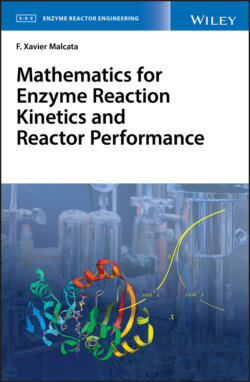Читать книгу Mathematics for Enzyme Reaction Kinetics and Reactor Performance - F. Xavier Malcata - Страница 20
2.1.2 Geometric Series
ОглавлениеA geometric series is said to exist when each term is obtained from the previous one via multiplication by a constant parameter, k, viz.
(2.86)
– and is said to possess ratio k and first term u0; after factoring u0 out, Eq. (2.86) becomes
(2.87)
An alternative form of calculating ensues after first rewriting Eq. (2.87) as
(2.88)
where the first term of the summation was made apparent; multiplication of both sides by k unfolds
(2.89)
where straightforward algebraic rearrangement leads to
(2.90)
Ordered subtraction of Eq. (2.90) from Eq. (2.88) generates
(2.91)
where may be factored out in the left‐hand side and u0 in its right counterpart to obtain
(2.92)
upon canceling out symmetrical terms in the right‐hand side, and dividing both sides by 1 − k afterward, Eq. (2.92) becomes
(2.93)
Note that k = 1 turns nil both numerator and denominator of Eq. (2.93), so it is a (common) root thereof; Ruffini’s rule (see below) then permits reformulation of Eq. (2.93) to
(2.94)
that mimics Eq. (2.87), as expected. Revisiting Eq. (2.72) with division of both sides by u0, one may insert Eq. (2.93) to get
(2.95)
Eq. (2.95) is illustrated in Fig. 2.5. Upon inspection of this plot, one anticipates a horizontal asymptote for k = 0.5 (besides k = 0); in general, one indeed finds that
(2.96)
at the expense of Eqs. (2.72), (2.73), and (2.95), which is equivalent to
(2.97)
– and reduces to merely
(2.98)
should k lie between −1 and 1, as it would give rise to a convergent series (i.e. kn + 1 → 0 when n → ∞, in this case). All remaining values, i.e. k ≤ −1 or k ≥ 1, produce divergent series – as apparent in Fig. 2.5; when k is nil, Eq. (2.93) turns to just
(2.99)
which corresponds to the trivial case of only the first term of said series being significant – and fully consistent with Eqs. (2.97) and (2.98).
Figure 2.5 Variation of value of n‐term geometric series, Sn, normalized by first term, u0, as a function of n – for selected values of ratio, k.
An alternative proof of Eq. (2.93) comes from finite induction; one should first confirm that it applies to n = 0, i.e.
(2.100)
Furthermore, one should prove that, if Eq. (2.93) is valid for any given n, then it will necessarily apply to n + 1, viz.
(2.101)
according to Eq. (2.87), one has it that
(2.102)
per definition – or, after splitting the summation,
(2.103)
Elimination of parenthesis transforms Eq. (2.103) to
(2.104)
where Eq. (2.87), coupled with validity of Eq. (2.93) for a given n permit transformation of Eq. (2.104) to
(2.105)
once u0 is factored out, Eq. (2.105) becomes
(2.106)
and elimination of parenthesis produces, in turn,
(2.107)
Cancelation of symmetrical terms, complemented with condensation of factors alike transform Eq. (2.107) to
(2.108)
that coincides with Eq. (2.101); therefore, Eq. (2.93) will be valid for n + 1 provided that it holds for n – and one accordingly concludes, together with its validity for n = 0, that Eq. (2.93) is universally applicable to (every) n.
